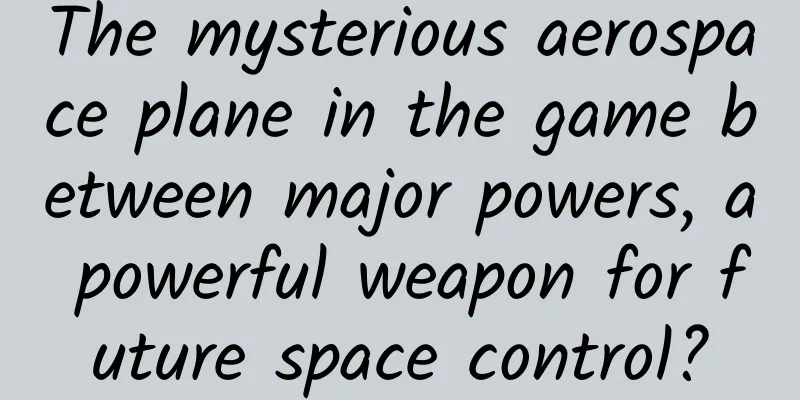The mysterious aerospace plane in the game between major powers, a powerful weapon for future space control?

|
In the past few days, news about the test of China's space plane has been all over the Internet, sparking heated discussions and causing a frenzy among netizens. As a Chinese, I am also sincerely happy and proud of the progress of China's space industry. But the question is, has my country's space plane really reached the level of competing with the United States as some netizens describe? Scientific issues must be analyzed with a scientific attitude. Let’s discuss it together now. The space shuttle is an upgraded version of the space shuttle. Space planes are the product of a high degree of integration of aviation and aerospace technologies, and are the most cutting-edge trend in the future development of aerospace. The degree of mastery of this technology can demonstrate a country's scientific and comprehensive strength. However, space planes are not something that anyone can make, nor can anyone make them well. In fact, the space shuttle was developed on the basis of the space shuttle. Some people compare the space shuttle to an upgraded version of the space shuttle. The world has only had space shuttles in the past, and only the United States has put space shuttles into practical use. The United States began to include space shuttles in its development plan in 1972, and developed the first space shuttle "Enterprise" in 1977. Since then, it has successively launched "Challenger", "Discovery", "Atlantis", "Endeavour" and so on. Except for the first "Enterprise" which was mainly used for testing and never carried out manned missions, the other five space shuttles officially carried out space missions from 1981 until they were all retired in 2011, leaving a glorious page in the history of human space flight. In the past 30 years, these space shuttles have carried out 135 manned missions into space, transporting 852 astronauts. The shuttle with the most missions is Discovery, which has carried out 39 manned missions, 252 astronauts, and a total of 365 days in orbit. Two space shuttles exploded during their missions. One was the Challenger, which exploded and disintegrated during the launch of its 10th space mission on January 28, 1986 due to the failure of an O-ring on the right solid rocket booster. The other was the Columbia, which exploded and disintegrated at 9 a.m. on February 1, 2003 after completing its 28th space mission and returning to the atmosphere. Due to damage to the carbon heat shield, hot gases entered the fuselage, causing it to explode and disintegrate. These two accidents resulted in the death of 14 astronauts, which is the most tragic event in decades of space history. The lesson is very profound. It can be seen that in the space industry, even the slightest mistake can lead to irreparable accidents. During the space race in the last century, the Soviet Union also developed a space shuttle called "Buran", which was based on the American space shuttle and formed some of its own characteristics. This space shuttle only conducted one test flight, using the Energia carrier rocket to send it into the 250-kilometer suborbital of the earth, and landed smoothly after flying for 3 hours. After that, the Soviet space shuttle never went into space again, and the program was terminated by the then Russian President Yeltsin after the collapse of the Soviet Union. In fact, the United States began to conceive the development of space planes as early as 1960. At that time, they were called "trans-atmospheric vehicles" and were code-named X-15, X-23, X-24, etc. However, due to the limitations of technology at the time and various reasons, they did not succeed and the plan was shelved. It was not until 1986 that the United States drew on the successful experience of the space shuttle and restarted the space plane development plan. Since then, the United States has launched the X-30 and X-33 space plane test projects. The latter was once called the "Venture Star" project, but it ultimately failed. This is known as the first generation of space plane projects. In 1996, NASA (National Aeronautics and Space Administration) launched the X-37 project. After more than a decade of uninterrupted development, improvement and testing, it achieved its first successful flight in 2010. At this time, the model was already called "X-37B". Similarities and differences between aerospace shuttle and space shuttle The biggest similarity between the space shuttle and the space shuttle is that both can perform missions in low Earth orbit and return to the ground independently. They are reusable orbital spacecraft and are similar in appearance. However, there are many differences between the two, mainly as follows: First, the appearance is similar and different. It looks like the space shuttle is similar to the space shuttle, but one is bigger and the other is smaller. The space shuttle is relatively large. For example, the main body of the US space shuttle is 37.2 meters long, 17.27 meters high, and has a wingspan of 29.79 meters. It has three floors, including a flight control room, bedroom, bathroom, kitchen, gym, and storage room, which can accommodate 8 people. The cargo compartment is 18.3 meters long and 4.6 meters in diameter, and can carry 24 tons of cargo into space and 19.5 tons of cargo back to the ground. The space plane is much smaller. For example, the X-37B is about 8.8 meters long, 2.9 meters wide, and has a wingspan of 4.6 meters. Its cargo hold is narrow and can only carry about 2 tons of cargo. Therefore, the space plane can only be regarded as a mini space shuttle. Second, the functions are different. The mission of the space shuttle is relatively simple, mainly used for space exploration and to undertake the transportation mission between space and the ground; in addition to undertaking the mission of the space shuttle, the aerospace plane can also be used for commercial purposes, quickly shuttling between major cities in the world to transport goods or personnel; and can be used for military purposes, for reconnaissance, long-range strikes and bombing, and to compete for air and space supremacy. Therefore, compared with the space shuttle, the aerospace plane has the characteristics of more diverse and flexible missions. For example, the Shenlong aerospace plane currently under development in my country has two versions: a light fighter and a heavy bomber. Third, there is a difference in the launch method. The space shuttle can only be launched vertically using a rocket launcher, while the space plane can be launched vertically using a rocket or horizontally on a heavy aircraft, which has a more flexible launch method. Fourth, the power system is different. The space shuttle is only equipped with rocket engines suitable for space flight without oxygen, while the space plane is equipped with special aircraft engines and rocket engines at the same time. It can fly in space without oxygen, and can also use improved aircraft engines to fly aerobically after entering the atmosphere, thereby reducing the amount of oxidizer and fuel used. Therefore, the space plane has a higher technological content and a wide range of application prospects. It is reported that some countries are still researching nuclear-powered space planes, which may be launched in 2050. This will be a major leap in human aerospace technology, and its influence will not only affect the Earth's near-Earth orbit, but will also extend to future exploration and immigration activities on the moon and Mars. At present, only a few countries such as the United States, Russia, China, the European Union and Japan have this scientific and technological capability and strength. Even in these countries, the development of aerospace planes is fast or slow, good or bad. But generally speaking, aerospace planes are still in the experimental stage, and no country has put them into practical use. The US space plane X-37B/ The X-37B space plane was invested by the US government, developed by NASA and commissioned by Boeing, and manufactured by its "Phantom Works". It is the world's first space plane to enter practical flight tests. Its maximum speed can reach more than 25 times the speed of sound. Conventional military radar technology is ineffective against it. It is considered to be the prototype of future space fighters. In addition to performing conventional aerospace missions, the X-37B can also conduct military operations against enemy satellites and other spacecraft, including control, capture, and destruction. It can also conduct military reconnaissance against enemy countries and attack ground targets. Although the development of space planes in various countries is top secret, it has to be said that the US X-37B is the most exposed, and its spectacular appearance is everywhere on the Internet. This space plane is 8.8 meters long, 2.9 meters high, and has a wingspan of 4.6 meters, which is about 1/4 the size of a space shuttle. Its takeoff weight exceeds 5 tons. It looks like a sports car, with two tail fins erected at the rear. Since its launch in 2010, this space plane has been continuously tested for flight and has been launched six times. The first flight in 2010 lasted 225 days in orbit, and each flight lasted longer than the last. It is reported that a total of three aircraft of this type were manufactured, and the second flight test on March 5, 2011 was another one. It successfully returned to Earth on June 16, 2012, having been in orbit for 15 months. The third launch took place on December 11, 2012. The space shuttle was the same one that launched its first test mission in 2010. It did not return to Earth until October 14, 2014, having spent 671 days in orbit, breaking another record. On May 20, 2015, the X-37B carried out its fourth space mission. Unlike the previous strict confidentiality, the United States took the initiative to reveal before the mission that it would test a new type of high-efficiency propulsion system that can improve energy consumption during the flight. Randy Walden, director of the U.S. Air Force Rapid Response Capabilities Office, said that the previous three flight missions were mainly to verify the aircraft, and the focus of this mission will shift to testing experimental payloads. However, the specific test process is still a mystery, which has attracted great attention and speculation from the world's public opinion. Some people speculate that this is probably a real-life test of "strike global targets in one hour", indicating that the US space plane is close to being put into actual combat. This test ended in May 2017, and the flight time in the sky reached 718 days. The fifth test was launched on September 7, 2017, and returned on October 27, 2019, with a record of 780 days in orbit. The sixth test began on May 17, 2020, and is still in space today, reaching 820 days. How long will the X-37B stay in orbit? There is no news on when it will land. Some people believe that the ultimate goal of the X-37B's flight time is 2,000 days, which is not impossible, because Earth observation and communication satellites can usually operate for more than five years, and planetary probes can operate even longer. In a sense, the space plane is also a space probe, so it is not surprising that it can fly longer. The various interplanetary probes launched by the United States in the past have been operating for decades. For example, some probes and rovers working on Mars have been working for more than ten years and are still working. The Voyager 1 and 2 sister probes launched in the last century have been flying in space for 45 years. The farthest Voyager 1 is already 23.5 billion kilometers away from us and can still communicate with the Earth. Therefore, looking at the current state of aerospace development in the world, it is an indisputable fact that the United States' aerospace plane is far ahead of the world, without a doubt. China's Shenlong space plane/ The X-37B continues to show off its muscles, which has made some powerful countries and regions in the world eager to launch their own aerospace plane development plans. China's scientific and economic strength has been continuously improving in recent years, and it is natural that it is unwilling to lag behind in the aerospace plane, a major weapon that competes with national strength and combat power. However, China's space plane development plan is an absolute secret, with very few news reports and the media keeping it a secret. We can only piece together the development progress of China's space plane based on some fragmentary information on the Internet. As early as December 11, 2007, someone uploaded a picture of a mysterious aircraft on a military website. Under the belly of a Chinese Air Force H-6, this small "plane" was mounted, with the five-star red flag and the word "Shenlong" painted on the surface. This is widely considered to be the earliest photo of China's Shenlong space plane. Since the prototype test began in 2007, it means that China's space plane development began several years earlier. Since then, the Chinese government has repeatedly announced the successful launch and return of "reusable spacecraft", but the few words of news have never been accompanied by images, so people generally speculate that this is the test of China's Shenlong space plane. It is really like a dragon that can only be seen from the head but not the tail. Although there are many artistic compositions of China's aerospace plane on the Internet, it is really difficult to get a glimpse of its true appearance. This reminds me of Su Shi's wonderful poem describing Mount Lu: From the side, it is a ridge, from the front, it is a peak. It is different from far and near, high and low. I cannot recognize the true appearance of Mount Lu, because I am in this mountain. Foreign media have reported and speculated a lot about this, but Chinese media are very secretive. Some people explain this phenomenon as: it is too advanced to be displayed; the less information there is, the more profound the connotation is. People are relatively certain that China's aerospace plane has been tested at least twice. One was on September 4, 2020, when it was launched from the Jiuquan Satellite Launch Center using the Long March 2F carrier rocket and returned on September 6 after two days in orbit; the other was a few days ago on August 5, 2022, when it was launched from the same location and with the same rocket. The Long March 2F seems to have become the exclusive launch vehicle for China's space plane, because it is the only rocket suitable for launching a "reusable spacecraft" of this size and weight. Dr. Marco Langbroek of the Delft University of Technology in the Netherlands has been tracking the flight trajectory after the launch on August 5, and predicted that it would return and land in Lop Nur on August 15, which caused a sensation on the Internet. But in the end, the dragon was nowhere to be seen, and there was no follow-up report. Therefore, no one knows how capable our aerospace plane is and whether it can compete with the X-37B as some netizens say. Development trend of space planes in various countries around the world There is also very little news about the development of aerospace planes in some other countries, and their progress is far from the level of the X-37B, and there is still some distance to go before China's Shenlong. The EU is jointly building the so-called "20XX" space plane program, but claims that its main purpose is to open future space flights. Participants in this program include Germany, Spain, Austria, Switzerland, Italy, Belgium, the Netherlands, France and Sweden. With the support of the EU, these countries have been researching the "20XX" space vehicle project for three years. Germany is ahead of the curve. The space plane they developed is named "SpaceLiner". It is said that the flight time from Europe to Australia can be shortened to 90 minutes using this plane. The current progress is still in the stage of testing and verifying new technologies. The space plane developed by Russia is even more mysterious. Officials only call it "some kind of spacecraft" and "unknown spacecraft". According to reports, on the evening of September 9, 2021, Russia successfully launched a Soyuz-2.1V light carrier rocket from the 43rd launch pad of the Plesetsk Cosmodrome. What is different from the past is that this rocket is a bit weird. In addition to not having the conventional strap-on boosters in the past, there is also a bulge on each side of the fairing. From this, the outside world speculated that it might be the Russian version of the X-37B. Although India is still far behind in its plans for manned spacecraft and space stations, it is naturally unwilling to lag behind in the space plane project as it is immersed in the "dream of becoming a world power". As early as May 2019, it conducted a space plane test similar to the X-37B, one year earlier than my country. They used an S-9 solid rocket to send a technology verification aircraft named RLV-TD to an altitude of 64.8 kilometers for about 10 minutes, with a maximum speed of Mach 5. This test was not a real prototype, but a reduced-size model, and it did not actually enter low-Earth orbit, but it still achieved some results. At least it successfully verified the flight posture in the atmospheric environment, which was a step forward in the development of aerospace planes. Japan's development plan began to be more inclined towards peaceful use and civilian use. As early as 1988, the Japanese government's expert committee announced that it would spend $14 billion to build a 10-seat space plane that could fly in the Earth's low-Earth orbit at 30 times the speed of sound. The space plane takes off in the traditional way of taxiing on the runway, uses jet engines to accelerate the aircraft to Mach 10 in the atmosphere, and uses rocket engines to increase the speed when it reaches an altitude of 30 to 50 kilometers. Later, Japan proposed the H-II orbital aircraft plan, which also adopted vertical rocket launch and runway return, and threatened to build it in 2000. However, there is no follow-up to these two plans, and neither of them has been pulled out for a walk. There may be some countries in the world that are tinkering with this thing, but there is even less news, and it is possible that no one has yet made a name for themselves. From these limited pieces of information, we can see that the struggle for space control is taking place around the world. Will the future battle for space dominance definitely begin? Long ago, the United Nations had a series of laws on the peaceful use of space, and countries also signed an agreement on the demilitarization of space. But just as described in science fiction, the dark forest and the chain of suspicion seem to be devouring the human soul. With the continuous improvement of science and technology in the field of space, the good wishes of demilitarizing space seem to be shattered. Is this development trend a good or bad thing for human survival? We cannot make a conclusion at this moment, we can only wait and see. What do you think about this? Welcome to discuss and comment. This is the original copyright of Space-Time Communication. Please do not copy or infringe upon the copyright. Thank you for your understanding and support. |
<<: 103 times! A new record is born!
>>: Moles can also become cancerous! Check out if your mole is dangerous →
Recommend
Look! China's most magnificent animal wonders
This is the most magnificent animal wonder in nat...
Chrome will soon be updated for iPad to provide multi-window support, security checks and other features
According to foreign media reports, Google's ...
Find user pain points accurately in 3 steps and solve marketing problems!
In the previous article "The Essence of Mark...
What are the functions of Foshan milk tea shop WeChat mini program? How to set up WeChat mini program for milk tea shop?
After the Qingming Festival, the temperature bega...
17 must-have tools to improve iOS development efficiency
[[155464]] Time is money. Improved coding efficie...
Segment your users and how to conquer them one by one?
Today, we will talk about practical techniques fo...
Tik Tok promotion and operation methodology: 3 major principles and 6 major positioning methods!
First of all, from the perspective of short video...
Analysis of private domain traffic operation system!
What is private domain traffic ? How to operate p...
A collection of 50 medical beauty marketing cases and market research reports
A collection of 50 medical beauty marketing cases...
Dr. Mo complains: Apple's native apps are too difficult to use
The Verge, a US technology blog, published a comme...
How much does it cost to make a Tik Tok mini program? How much does it cost to develop a mini program for Douyin?
If we talk about the hottest platform now, it mus...
Taking the 98 Shopping Festival as an example, how to use product thinking to promote sales
The Purchase Festival on September 8, 2016 was th...
3 key points to discuss the strategy of hot-selling products
There are a wide variety of products today, and t...
Why is it so difficult to kill the “invincible” cockroach? Let’s see the battle between humans and cockroaches →
Cockroaches, scientifically known as Blatta, are ...
Lanzhou WeChat Mini Program Mall Ranking, What are the factors that affect the ranking of mini programs?
Open the APP on your phone, no matter which e-com...









